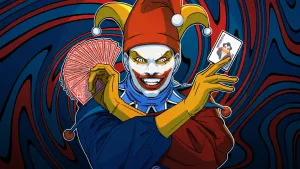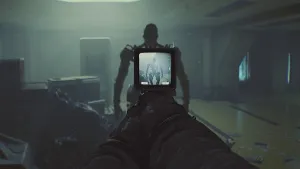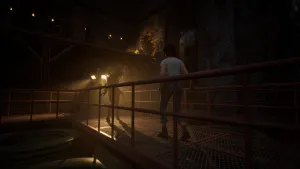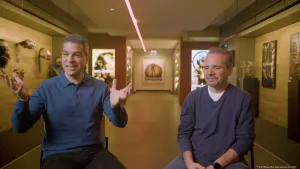Subscribe today to get the first appearance of Dragon Quest on our cover!
The Origins & World Of Horizon Zero Dawn

Horizon Zero Dawn was one of the games that got gamers buzzing at E3. Its mix of primitive man and animal-like machines in the distant future caught fire with our imaginations. We saw the game behind-closed-doors, which yielded additional info about the game not seen in its official trailer, but we also talked to Guerrilla Games' Mathijs de Jonge (game director) and Mark Norris (senior producer). The pair divulged even more about Horizon, from its creation to the some of the nuts and bolts of its gameplay.
In 2011, you had a
smaller team working on Horizon. Was that mainly art and general concept? Can
you talk about what that smaller team worked on and when you brought on the
other people, when it ramped up?
Mathijs de Jonge:
After we shipped Killzone 3, we asked our company to pitch IPs, and there were a
lot of people excited about starting something new. We got about 40 different
concepts, but there were a couple games that stayed close to what our company
can do, and inspired us. One of the concepts that was most appealing in terms
of different elements in it, funnily enough, was the most risky project there,
Horizon. That's the concept that we started prototyping with a smaller team.
I think at first we were 10 people and at maximum maybe 15 or 20. We built prototypes as much as possible. So we started this specific robot that you've seen, the Thunderjaw. That started out as a Duplo big block thing with very ugly animations. But the core elements that are on there now were very present in the early prototypes; we had the basics up and running quite early. And after Shadowfall shipped, the rest of the company joined the very small team. So we had everything prepared for when that switch was gonna happen. And now for a year and a half we've been working with the entire company on this game. I think it's actually has been really good that we have been able to define all of the rules of how this world operates, because it has such crazy elements mixed together. We wanted to make it feel like it was believable.
In terms of the
larger vision and bringing that together, would you say that some of the story
elements were the fundamental first blocks of putting the game together or was
it more about, "we want to do an action game that has some RPG elements"?
de Jonge: We
wrote early drafts of a possible story. We maybe wrote 20 different stories.
Very different stories. We explored with different player characters. We
explored multiple player characters. We explored many things to figure out what
worked best, because we already knew that it's going to be very lush and with
nature. Maybe 1,000 years in the future, with these robots roaming around that
look very animalistic. So, those core ingredients were already there. We have
been iterating on all these things the whole time.
Mark Norris: If you had to take a look at the foundational themes, this tribal society or primitive humanity. Humanity's struggle and survival is one of the things that Mathijs is constantly pushing for... This is a world full of danger. It's a world full of beauty and majesty, but we really wanted to get across the sense of, "what does this juxtaposition really look like? What if humanity is not at the top of the life list anymore? What would that feel like? What would that look like?" That drew a lot of the other elements around it. We brought in John Gonzalez, who was the former lead writer on Fallout: New Vegas to be the pen to the story. But, the major elements of the story have remained even though John has put his touch on it. So the story, at least the foundational elements of it, have remained intact over the period. Of course, it's gotten better as very good writers have come on to the story to help us flesh that out.
I'm not sure if that battle with the Thunderjaw is simply a demo example or if it's currently in place in the game. Can you say whether you would characterize that as a boss battle? Or would those kinds of encounters happen naturally, let's say, if you were just wandering around and got into the wrong situation?
de Jonge: These robots do roam around, and you can get into that situation, but the player would have to be at a high level to fight these, and have the right tools.
Norris: And you might run into that Thunderjaw at level six and that would be a bad time for you. [laughs] There are of course moments inside of the quests in which you'll have more scripted encounters. But 90 percent of this game takes place in the open world where you're running around and doing things. If you're in the wrong place at the wrong time, well...
In the battle against the Thunderjaw, she was using its tail projectile weapon against it. Is that anything you could keep or craft from?
de Jonge: The disc launcher, it's a very heavy weapon. You can walk around with it, but you can't jump, so it's a weapon that players will leave behind. It's sort of a power spike that we put in so momentarily the player feels very powerful against these big machines, but it's also something we want to take away, because otherwise...
Norris: Limited ammo.
Will there be any of the smaller weapons that would be native to the machines that you might be able to take with you if they've been blown off?
Norris: I don't think there's ever going to be anything inside of the game where you shoot a specific piece off the machine. Because the game is so based around crafting, it's always parts. And so there's never going to be a moment where you're like, "Oh that machine has a machine gun and now I've picked up that machine gun. Now I have a machine gun that I can put into my weapon slot."
de Jonge: That's right, plus we also felt like these robots are big, they're heavy, so how does that even work? How would she put that in a backpack? It doesn't even make sense. That's our reasoning for getting these very powerful things. They stay with the robots, more or less, or in their region, and the other weapons that are still very powerful for the player, you craft them for yourself. The ammo you craft yourself from bits and pieces from the machines.
Can you talk about
how players will approach the open world as far as getting objectives,
missions, and things to do?
Norris: So there
are obviously things that will have objectives and objective markers inside of
the game, and another thing that we mentioned during the demo here is the
exploration element. We want to drive exploration through having pick-ups that
you'll find throughout the world that you can craft with or replenish your
health. So, there will be reasons for
you to explore this open world that are meta-game related, but there are also
quests and a quest system in place that will deliver that story and give you
specific places to go.
Read on to find out more about the game's world, crafting, and things Guerrilla is not supposed to talk about.

The protagonist is definitely a skilled hunter but we, as humans, are at a disadvantage to these animals, these machines. You also mention a leveling system, that there are good times and bad times to meet these machines along your travels. But how would you characterize most peoples' gameplay? Are they going to expect to be at a disadvantage, or are there going to be moments where they're going to be all-powerful and mow down fodder?
de Jonge: The way we try to design it, is that in the beginning of the game the smaller robots are a challenge, but as you defeat those and level up, you will face more difficult machines but also still see the smaller ones walk around. You become more powerful than the smaller ones. You keep going up in ranks but it will take a lot of hours to completely be able to mow things down. In the end, that will probably be something we want to avoid. We always want to retain some level of challenge, because that's what the game is built around.
Norris: It's certainly not analogous to say the old Morrowind or Oblivion systems where everything levels with you, so you never feel a power differential, you will feel that power differential in our game. As Mathijs mentioned, that comes far more from I'm able to take on these bigger challenges that I wasn't able to take on earlier more than god-modeing through this super difficult thing at the beginning of the game that is now super easy. The world changes in Horzion, and it will probably continue to change as you play through.
Can you talk about
the machines' behavior and some of the systems in place behind them as far as
governing how they interact with you – not in a combat sense – but just when
you encounter them and their place in the larger world? The ecosystem, so to
speak?
Norris: That's
actually one of the questions that we're going to try and avoid. Not because we
don't want to answer it, but because it's such a crucial part of this
experience, that starting to answer that gives away big reveals. That Mathijs
is very keen on making sure that these mysteries don't get out.
de Jonge: We have a big do-not-talk-about list.
Is there anything you
can say as far as the travel structure and how different humans relate to each
other?
Norris: What we
can't say is anything specific. What we can't say is the number of tribes or
other specifics. What we can say is that the tribes are very different from one
another. I can say that because as you saw in the press conference they are
dressed differently. They look different from one another. You saw one with a
majestic city. You saw one that is almost transient in a way. That is a
critical part of the game. Aloy will come across those tribes and each of those
tribes has their own unique and interesting story that you'll get into.
You mentioned the
crafting and some of the stuff you'll pick up. Is there anything you can say about
the overall economy system? Will the worth of players' goods fluctuate at all?
de Jonge: The
game is very much built around the economy of the role of resources. Players
can go into merchants and sell resources. We also have traders that trade
resources directly so you don't have to sell that stuff. How shops and
merchants exactly work that's something we're still fleshing out. But the most
important bit is also that the player actually crafts a lot of the stuff so
there is a creative element in a way in that. I'm collecting this bit from
nature and this bit from a robot. I get this other ingredient from the tribes
and now I'm going to put this thing together. So we have an interface for that
as well where you get the sense of actually making something. I think that's also
a bit of what makes it feel more unique. We have these robot components that we
add on to the tribal, primitive ingredients and then add a bit of nature as
well. Creates a very unique mix.
Some games get a bit
overboard with their crafting menu systems. How are you guys going to tackle
that in the game so players aren't intimidated by the menu or encumbrance, etc.?
Norris: One of
the things you just saw in the behind-closed-doors demo is that we have the
quick-craft menu. Because we're an action RPG, everybody calls themselves open-world
action RPGs. At this point, that's really hard for gamers to understand, so if
we were to put this on a graph, you would say, on the far left is Watch Dogs or
Far Cry, where the menus are simple, not super in-depth. You could do a lot of
things just inside of the wheel. Specifically in Watch Dogs they allow you to
craft inside of that wheel as well. On
the right side of the spectrum, you'd have your Witcher 3s and you have to jump
into the menu just to put oil on your sword, or a Skyrim or a Fallout. I don't
think any of those are wrong. Those
games, on the left side, are more action RPGs and on the right side it's more
RPGs with action on the back end.
For us, interestingly, we're carving out a spot almost in the middle of the spectrum. We don't want to be inundated with U.I. [user interface - ed.]. I know Mathijs is constantly trying to keep the U.I. very simple. And we certainly don't want very complicated menus. One of the things that would be bad is [for players to say], "Hey, I don't know exactly how I do this," or "I have all these resources but I don't know how they map to the different things." But we're working on all of that stuff.
Does Aloy have skills
you would upgrade?
de Jong: Absolutely.
One of the core ideas for setting up the character is that, in a lot of games
you get a selection of what player you are, a combat player or stealth player.
In our game we wanted to keep that completely open for the player. You can mix
and match and put it together in any way you want. Also during the game you can
switch. So the different weapons we present, you can work with the weapon wheel
and customize it, but also with the skill trees they are very open. As the
player levels up, you get skill points, you get to spend them on the skill
trees. There, you can go in all directions you want. You can really create your
own custom character instead of having to go through this fixed path and not
being able to switch things around.
Is there anything different in development transitioning from the first-person shooting of Killzone to how you guys want the action to be now? Or is it all the same?
de Jonge: There are some similarities. I think it has been very good for us to have built a number of Killzones, triple-A console products to be able to make a game like this. This, in terms of scope and open world – you can you approach the combat from any direction, and you're fighting many of these big machines – we couldn't have done it as our first game. So, developing these Killzones has taught us a lot of things. But there are some things like in the combat how you set up weapons, how to tweak combat distances, how cameras work, all of that stuff, that stuff we already learned that we can take all into this game and develop on it. And the feel on the controls that's also something we focus a lot on to get the controls to be in a place where the player feels in control, where it's very responsive and still have nice character animations – which is really difficult thing to have something look nice and play very nice.
In creating an open world, is the challenge a technical one, or about the overall game design and how you react to what players want to do?
Norris: It's a production challenge. And it's a challenge for all areas of the studio. From a technical standpoint, the engine was built for corridor-based linear shooters. So, having to build in a streaming system and a brand-new memory profile, having to take a look at how we do certain things in terms of draw distances and loads, and levels of detail, it's an incredibly large technical challenge. It's an incredibly large personnel challenge.
As Mathijs mentioned in the last answer, they know moment-to-moment action combat as well as or better than almost any studio in the world. But, they've had to bring in design talent to take a look at how level design works slightly differently in open world games. They've had to bring in art talent to take a look at how they actually have to repeat certain things, what sort of technical art is required in order to instance those things in a way that will allow those things to be beautiful and not make them exactly the same over and over and over again. These are things other studios have figured out in the open world space but that this studio is solving those problems for the first time. But I think, as you're seeing it now, we're feeling somewhat good about it so far. We're excited.
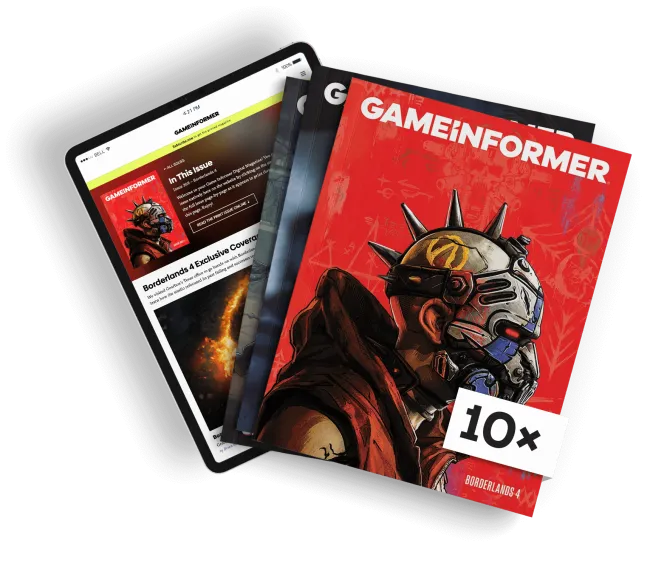
Get the Game Informer Print Edition!
Explore your favorite games in premium print format, delivered to your door.
- 10 issues per year
- Only $4.80 per issue
- Full digital magazine archive access
- Since 1991


